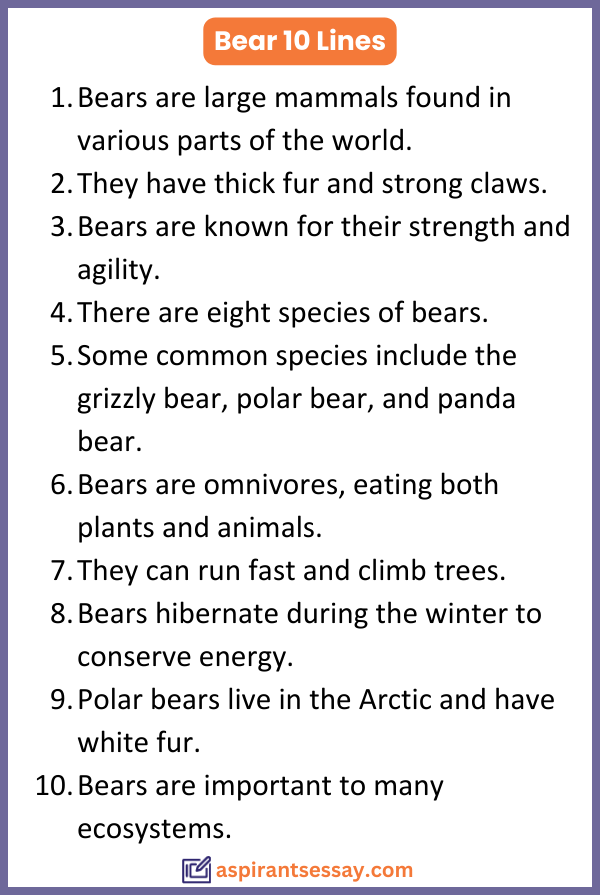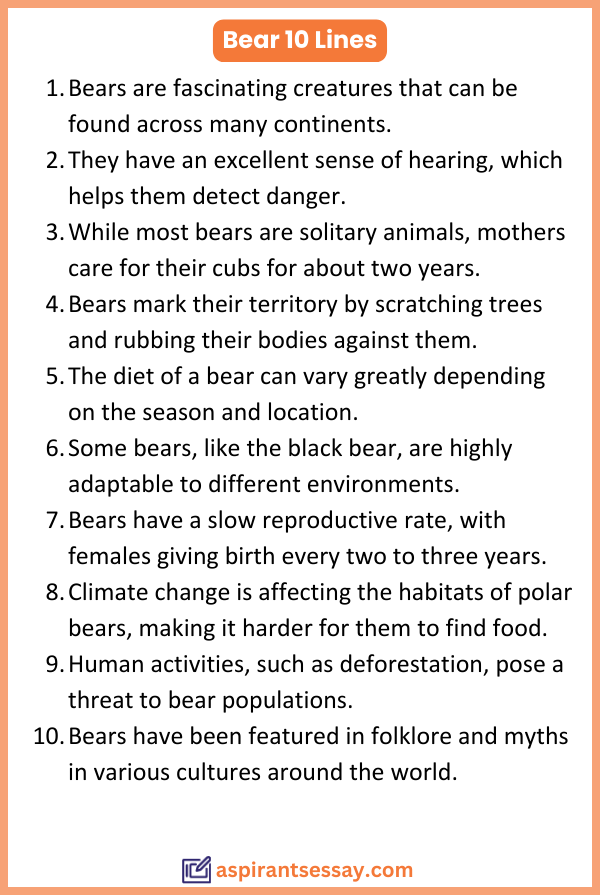Bears are large, intelligent mammals found across many continents. With diverse diets and habitats, they play crucial ecological roles. Their adaptations, such as keen senses and thick fur, help them survive in various environments. Conservation efforts are essential to protect these remarkable creatures and their ecosystems.
Here, we’ve presented multiple samples of 10 lines on “Bear”. All the samples will be helpful for students of all classes i.e. Nursery, LKG, UKG, 1, 2, 3, 4, 5, 6, 7, 8, 9, 10, 11 & class 12.
10 Lines on Bear: Sample 1
- Bears are large mammals found in various parts of the world.
- They have thick fur and strong claws.
- Bears are known for their strength and agility.
- There are eight species of bears.
- Some common species include the grizzly bear, polar bear, and panda bear.
- Bears are omnivores, eating both plants and animals.
- They can run fast and climb trees.
- Bears hibernate during the winter to conserve energy.
- Polar bears live in the Arctic and have white fur.
- Bears are important to many ecosystems.

Bear 10 Lines: Sample 2
- Bears are found in forests and mountains.
- They can weigh hundreds of pounds.
- Bears have a keen sense of smell.
- They can swim well, especially polar bears.
- Baby bears are called cubs.
- Bears communicate through sounds and body language.
- Some bears, like the panda, eat mostly bamboo.
- They play a key role in spreading seeds in forests.
- Bears can stand on their hind legs to look around.
- Conservation efforts help protect bear habitats.
10 Lines About Bear: Sample 3
- Bears are fascinating creatures that can be found across many continents.
- They have an excellent sense of hearing, which helps them detect danger.
- While most bears are solitary animals, mothers care for their cubs for about two years.
- Bears mark their territory by scratching trees and rubbing their bodies against them.
- The diet of a bear can vary greatly depending on the season and location.
- Some bears, like the black bear, are highly adaptable to different environments.
- Bears have a slow reproductive rate, with females giving birth every two to three years.
- Climate change is affecting the habitats of polar bears, making it harder for them to find food.
- Human activities, such as deforestation, pose a threat to bear populations.
- Bears have been featured in folklore and myths in various cultures around the world.

5 Lines on Bear
- Bears are powerful animals that live in diverse habitats.
- They have sharp claws and teeth for hunting and foraging.
- Some bears, like the brown bear, can weigh up to 1,500 pounds.
- Bears are skilled at finding food and can eat a wide variety of things.
- Conservation efforts are crucial to protect bear species and their environments.
20 Lines on Bear
- Bears are part of the Ursidae family and can be found in North America, South America, Europe, and Asia.
- They have a diverse diet that includes fruits, nuts, leaves, insects, and fish.
- The polar bear, which primarily eats seals, is the largest carnivorous bear.
- Bears have a large brain relative to their body size, indicating high intelligence.
- They can solve complex problems, such as opening containers to access food.
- Bears have a keen sense of smell, which is stronger than that of a dog.
- This strong sense of smell helps them locate food from great distances.
- They communicate through vocalizations, body language, and scent markings.
- The panda bear, native to China, primarily eats bamboo and has a thumb-like extension on its wrist.
- Bears enter a state of torpor, similar to hibernation, during the winter months.
- During this time, they survive on their stored body fat.
- Cubs are born blind and helpless, relying on their mothers for warmth and nourishment.
- Bear populations are threatened by habitat loss and climate change.
- In some cultures, bears are revered and play a significant role in mythology and folklore.
- The bear’s thick fur insulates them against cold temperatures and harsh weather.
- Bears can swim long distances, which is especially crucial for polar bears in the Arctic.
- The sun bear, the smallest bear species, has a long tongue to extract honey from beehives.
- Bears have a varied lifespan, with some living up to 30 years in the wild.
- They play an important ecological role by dispersing seeds and nutrients through their scat.
- Protecting bear habitats not only helps the bears but also preserves the biodiversity of their environments.
